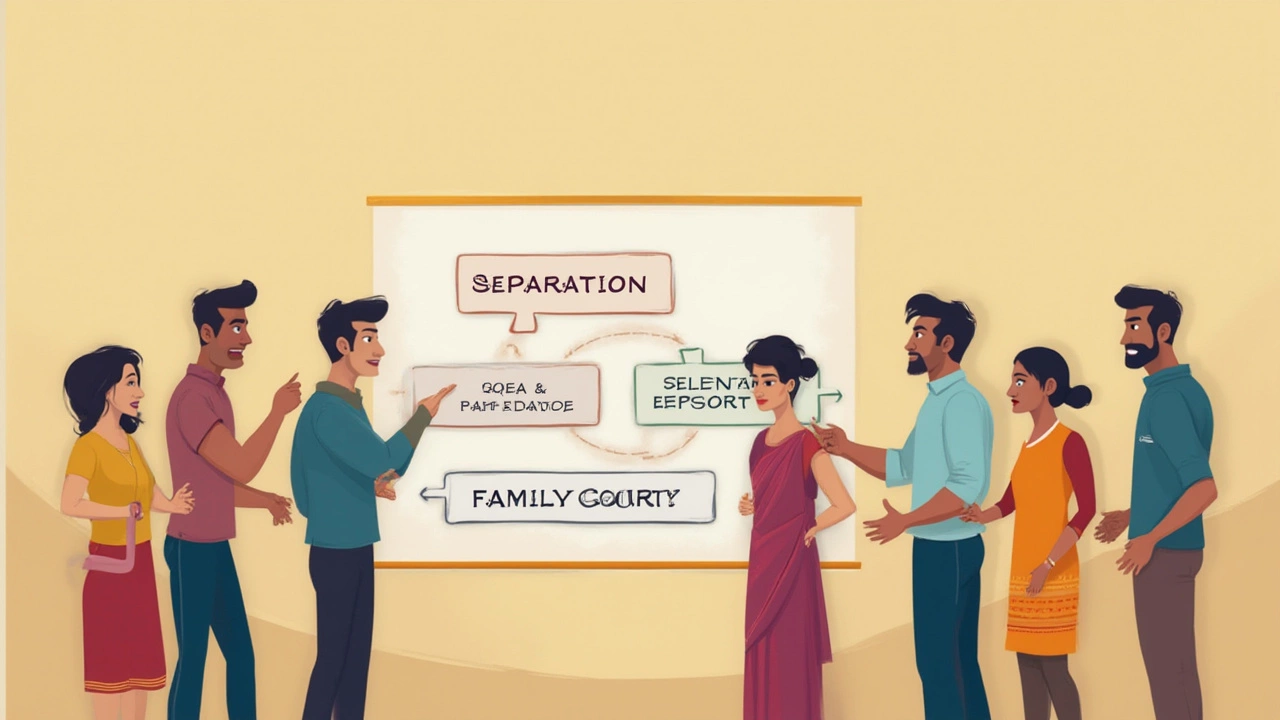Ever heard stories of couples announcing their split, but still living in the same flat for months? Or families in India telling you that you have to “live apart for years” to even think of starting a divorce? Rumours and random advice swirl around divorce all the time, leaving people confused and stuck at a tough crossroad. So here’s the truth behind the drama: Is it truly mandatory to live separately before filing for divorce in India—or is there more flexibility in the law than you’ve been led to believe?
What Does "Living Separately" Mean Under Indian Divorce Law?
If you check the Indian legal books, you won’t see any clear, blazing sign saying, “You must move out to get divorced.” Instead, ideas like ‘living separately’ pop up in two main ways: mutual consent divorce, and contested divorce on the grounds of separation. It’s these two situations where things often get lost in translation. Plenty of folks get the impression that unless both spouses physically move to different cities or even countries, the court won’t listen. But the Supreme Court of India tackled this directly in 2000 (Smt. Sureshta Devi v. Om Prakash): living separately doesn’t only mean different roofs, but simply that you’re not living as husband and wife. You could even stay under one roof and, as long as there’s no “marriage-like” relationship—no physical intimacy, no social or family life together—it counts as living separately. The tricky part is that Indian families are often joint, sharing crowded apartments, so many couples continue sharing space for financial or social reasons even after things break down. The courts get this.
Let’s talk numbers. The Hindu Marriage Act (1955)—the main law for Hindus—says if both partners want a mutual consent divorce, they need to have lived separately for at least one year. But again, “living separately” here doesn’t require changing addresses. Courts have said it’s the intention and the social/physical separation that matters, not geography. Instead, the test is, did you stop acting as husband and wife, or are you just “roommates for now”? Real-world example: in 2017, the Delhi High Court granted divorce to a couple who shared the same house, but did not speak or interact as a married couple for over a year. The neighbours confirmed it, their relatives confirmed it, and the court said that was proof of separation.
Now, what about people who just can’t afford to move or who have kids and want to keep the same home for stability? Courts often accept that. The legal bar is not about having a new address for your Aadhar card, but whether the marriage has “irretrievably broken down.” Most judges get that families in India live all tangled together, and that reality is far from the neat “move-out” idea you might see in Western countries.
So is it mandatory to move out? No. Is it necessary to stop living as a married couple—emotionally, physically, and socially? Yes. If you’re using the ground of mutual consent, you both must tell the court that you’ve lived separately—however that looks—for one year.

The Divorce Process: Steps, Proofs, and Court Expectations
The nitty-gritty of a divorce isn’t just what happens between two people. Once lawyers and judges get involved, they need evidence, statements, and a paper trail that proves you really have separated—even if “separated” just means cold silence at the dinner table and living at opposite ends of the same flat. So how does this work in practice?
First, if you apply for a divorce by mutual consent under Section 13B of the Hindu Marriage Act, both of you must jointly file a petition. The form will ask whether you’ve been living separately for at least one year. What if you never rented a new place? Don't stress. Courts accept witness statements, affidavits from friends or family, or proof of totally separate lives—even if the address is the same. Here’s the typical evidence that works:
- Affidavits from neighbors or relatives describing the lack of interaction
- Chat messages/screenshots showing zero communication or fighting
- Proof of separate bank accounts, bills, or support payments
- Children’s school documents showing one parent involved
- Therapy or counseling records (nothing private is shared unless you allow it—you can just provide a confirmation of sessions)
What if it’s a contested divorce—that is, only one spouse applies on grounds such as cruelty or desertion? Here, too, “desertion” requires two years of living separately, but, again, it’s the ending of the marital relationship that counts, not a change of street address. There was an eye-opening Kerala High Court case in 2010: a couple fought over whether living in different bedrooms for three years was enough separation. The court decided yes, because they lived “as strangers in the same household.”
Now, a tip for keeping everything smooth: document everything. In India, divorce cases sometimes drag for years, and the court’s main worry is making sure no one’s being coerced or lying to skirt the law. Save any written communications, make a note of key dates (when separation actually happened), and try to involve neutral third parties (even a neighbour) if there are disputes about how separate your lives really are.
Check out this breakdown of some key Indian divorce statistics and timelines:
| Type of Divorce | Minimum Required Separation | Average Duration to Completion* | Notes |
|---|---|---|---|
| Mutual Consent (Hindu Marriage Act) | 1 year | 18-24 months | Both must confirm separation for a year, physical separation not mandatory |
| Contested (Desertion, Cruelty) | 2 years (desertion only) | 3-5 years | Proof required of loss of “married life,” even under one roof |
| Christian Divorce (Indian Divorce Act) | 2 years (in most cases) | 2-4 years | Varies by ground; emotional/physical separation counts |
| Special Marriage Act (any religion) | 1 year | 2-3 years | Similar approach: emotional/social separation |
*Duration can stretch longer if disputes arise or if courts are congested with cases. Mutual understanding, paperwork, and clarity make things a lot quicker.
The Indian system expects some basic evidence of your “irretrievable breakdown.” So if you have no communication with your spouse, no shared social activity, and are financially independent, even if living in the same house, courts accept that as being “separate.” Joint family setups? Still counts if the married couple act as strangers.

Myths, Realities, and Practical Tips for Living Separated Without Moving Out
Every time I chat with friends or family back home in Mumbai or here in Sydney, stories pop up about “rules” no one can trace. Like, your mother-in-law telling you “her neighbour’s cousin’s son” had his divorce application rejected because the couple were seen having tea together. Or that you can’t even begin paperwork unless you have a new rental agreement (with a police verification thrown in for good measure). Almost all of this is plain old hearsay.
Let’s pop the biggest myths wide open. First, you don’t need to be living in two completely different homes. You need to be living “as if you’re not a couple.” Second, even if you have children together and want to keep the same address, courts focus only on the parent’s relationship, not their shared parenting. Third, while separation for one year is a requirement in mutual consent cases, there is a provision under Section 14 that lets the court reduce this period in “exceptional hardship”—like domestic violence, severe illness, or urgent relocation.
Here’s what many people don’t know: you don’t have to make a fuss or parade your separation on social media. Quiet proof—a witness, a neighbour’s statement, some bills or documentation—is usually enough, provided it’s credible. If you’re thinking about taking this hard step, save copies of key documents, keep a journal of events, and talk to a reliable lawyer about honest, workable evidence that shows your story.
Some quick, real-life tips:
- If you share a house, try to move into different rooms—don’t share a bedroom, bathroom, or kitchen if possible.
- Tell a few trusted people about your living arrangements—they might be called as witnesses if needed.
- Be consistent in what you say in court and to others—judges look for contradictions.
- If you have kids, clarify custody and support responsibilities in writing. Courts want proof that the children’s interests aren’t being ignored.
- If money’s an issue (as it is for a lot of families), make a note in the petition. The judge will understand that moving out is sometimes impossible.
Who actually checks all this? Not some court detective. Usually, a judge just looks at the petition, submissions, and sometimes calls both spouses for a hearing to ask questions. If your facts are solid and evidence lines up, the chances of refusal are slim (unless someone is clearly lying or hiding something major).
Here’s something that still shocks many people: most Indian states don’t have an exact “divorce police force” to spy on your daily life. The process is far less about a literal new house, and more about whether your life matches your story. Attempts to fake separation—like abruptly changing your address with no matching change in behaviour—often backfire. Indian judges are rarely fooled by a superficial show.
So, next time someone claims you need to “pack up and leave” before even starting a divorce, remember: that’s not what the law says, and it’s not how the courts work. The rules focus on real, lived separation—not empty posturing. Plan smartly, start collecting evidence early, and remember, the law is on your side if what you’re going through is real. Be honest with yourself—and the court. Divorce isn’t easy, but you don’t have to jump through imaginary hoops just because someone swears by them at a family get-together.
And one last tip: if you want speedy closure, try to avoid ugly scenes and keep the paperwork clean. Your judge has seen it all—fake splits, real heartbreak, dramatic lies, and quiet truths. As long as you show honest, consistent evidence of living apart in spirit (even under one roof), you’re on the right side of the law. That’s the real test in Indian divorce courts today.


